veSQuj
Chess with 21st-century armies
By Glenn Overby (2005)
Introduction
veSQuj, which means "game of warfare" in Klingon, is a modern-themed chess variant. Early versions of chess used pieces that symbolized the normal features of armies and battle. veSQuj takes this concept into the modern age, using the main arms of land, sea, and air overseen by a marshal in command, with a head of state that does not directly lead the military in battle.
veSQuj was originally conceived for a traditional chess set, giving new powers to the pieces. It can still be played with a Western chess set. The game was submitted to the 10th anniversary contest of the Chess Variant Pages, meeting the contest theme by using 10 pieces per player.
Setup
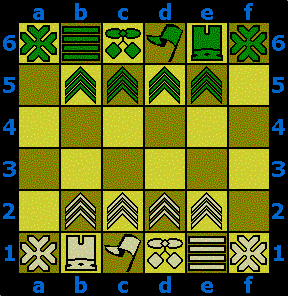 |
||
|---|---|---|
Graphics and ZRF by Glenn Overby. |
||
| White | Pieces | Black |
| c1 | President | d6 |
| a1/f1 | 2 Brigadiers | a6/f6 |
| b1 | Marshal | e6 |
| d1 | Wing-Commander | c6 |
| e1 | Captain | b6 |
| b2/c2/d2/e2 | 4 Sergeants | b5/c5/d5/e5 |
a b c d e f
+---+---+---+---+---+---+
6 | b | c | w | p | m | b | 6
+---+---+---+---+---+---+
5 | | s | s | s | s | | 5
+---+---+---+---+---+---+
4 | | | | | | | 4
+---+---+---+---+---+---+
3 | | | | | | | 3
+---+---+---+---+---+---+
2 | | S | S | S | S | | 2
+---+---+---+---+---+---+
1 | B | M | P | W | C | B | 1
+---+---+---+---+---+---+
a b c d e f
|
||
Rules
- There are two players, White and Black. White moves first.
- A player moves one piece each turn. Players alternate turns.
- Each piece has a distinctive pattern of allowed moves, given at Pieces below.
- Pieces may not leap over other pieces, unless their move description allows it (Brigadier's knight-move, Marshal's knight-move, Captain's two-square moves).
- Pieces may not move onto spaces occupied by friendly pieces.
- Pieces which move onto the space of an enemy piece capture that piece and remove it from the game.
- A Sergeant which traverses the board to the opponent's first rank immediately promotes to Brigadier, Captain, Marshal, or Wing-Commander. But a Sergeant may only promote to a piece previously lost by that player.
- A player wins the game when:
- The opposing President is captured; or
- The opponent has no legal move.
Pieces
| Brigadier | 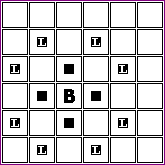 |
A Brigadier combines two moves. It can move one space horizontally or vertically, or like an ordinary knight in a big L-shape, in a 1+2 or 2+1 pattern. The L-shaped move ignores intervening pieces. |
|---|---|---|
| Captain | 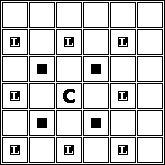 |
A Captain combines three moves. It can move one space or two spaces diagonally, or exactly two spaces horizontally or vertically. The two-space moves ignore intervening pieces. This combines the ferz, alfil, and dabbabah of several historic games. |
| Wing-Commander | 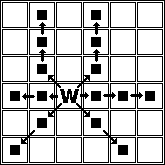 |
A Wing-Commander combines three movements. Forward, it may move one space diagonally, and then may continue by turning 45 degrees and sliding along the file like an ordinary rook. (Imagine dual machine guns or missiles in a fighter plane.) Sideways, it may slide along the rank like an ordinary rook. Backward, it moves as an ordinary bishop, sliding any clear distance along the diagonal. (Now imagine wings.) |
| Marshal | 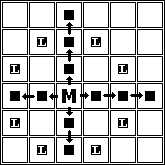 |
A Marshal combines two moves. It can move any distance horizontally or vertically, without leaping over any piece, like an ordinary rook. It can instead move like an ordinary knight in a big L-shape, in a 1+2 or 2+1 pattern. The L-shaped move ignores intervening pieces. |
| Sergeant | 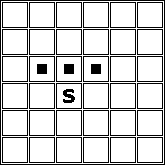 |
A Sergeant can move or capture one square forward or diagonally forward. (There is no double-step option or en passant.) When a Sergeant reaches the opponent's back rank, all the way across the board, it may promote to Brigadier, Captain, Wing-Commander, or Marshal. But promotion is limited to pieces previously captured by the opponent and still available. (A player may not have three Brigadiers or two Marshals, for example.) |
| President | The President, as a modern head of state, does not lead the army to battle. In fact, the President cannot move unless attacked! If in check, the President may move by trading places with any piece on the same side except a Sergeant. (The military whisks her away to a refuge.) |
Comments
Playing tips
To destroy the President, destroy the defenders. Each major piece slain directly impacts the President's ability to run.
There are only two long-range pieces in each army. The Marshal and Wing-Commander thus figure in many decisive attacks.
Sergeant promotions are hard to come by. But getting a Sergeant to attack the President from the next-to-last rank is likely to score both a promotion and a win. If the President moves away, by definition a major piece will be exposed in its place. The Sergeant then captures that piece and promotes.
Attack, attack, attack!
Piece histories
The Brigadier has been reinvented many times. Under different names, it appears in such games as Way of the Knight, Scirocco, Thronschach, and Lùotuoqí. It was assigned a land-theme name, to be later complemented by sea and air power.
The Captain was popularized in Ralph Betza's Chess With Different Armies, under the name FAD (from Ferz-Alfil-Dabbabah). It was assigned a sea-theme name because it is colorbound on a chequered board.
The Wing-Commander was invented for this game. As the long-range piece of the three intermediate army leaders, it was given the air-theme.
The Marshal is a very old piece. Under other names it dates back as far as 1617. Marshal is one of the most widely accepted names of this well-known combination, and is an obvious choice for a supreme military commander.
The Sergeant combines the moves of an ordinary and Berolina pawn. It goes back to at least the 1940s in the West, and earlier as an Iron General in Japanese games.
The President's move was invented for an early version of this game, although it first saw publication in my hexagonal chess game Panal.
Computer Play
If you have Zillions of Games installed on your computer, you can play this game. Download file: vesqujzog.zip.
A Game Courier preset is being written.
Examples of Play
"Two-to-One Odds"
- Black to move and win.
- If Black missed this, and played Be3xc2 capturing the Sergeant with the Brigadier, how should White respond?
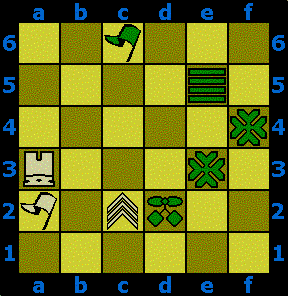
a b c d e f
+---+---+---+---+---+---+
6 | | | p | | | | 6
+---+---+---+---+---+---+
5 | | | | | c | | 5
+---+---+---+---+---+---+
4 | | | | | | b | 4
+---+---+---+---+---+---+
3 | M | | | | b | | 3
+---+---+---+---+---+---+
2 | P | | S | w | | | 2
+---+---+---+---+---+---+
1 | | | | | | | 1
+---+---+---+---+---+---+
a b c d e f
Solution
"Last Shall Be First"
White's last move was Mb1-d1, doubling the pin on the Black Brigadier at d5 and increasing the pressure on the President. Although a Captain down, White has found some counterplay.
- Black to move and win.
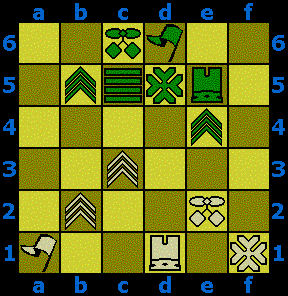
a b c d e f
+---+---+---+---+---+---+
6 | | | w | p | | | 6
+---+---+---+---+---+---+
5 | | s | c | b | m | | 5
+---+---+---+---+---+---+
4 | | | | | s | | 4
+---+---+---+---+---+---+
3 | | | S | | | | 3
+---+---+---+---+---+---+
2 | | S | | | W | | 2
+---+---+---+---+---+---+
1 | P | | | M | | B | 1
+---+---+---+---+---+---+
a b c d e f
Solution
Equipment
veSQuj can be played with an ordinary Western chess set, by ignoring the edge squares of the board. The inventor uses:
- A King for the President.
- Four Pawns for Halberdiers.
- A Queen for the Marshal, the most powerful piece.
- A Rook for the Wing-Commander, which has the sideways Rook-move (and others).
- A Bishop for the Captain, which is also "colorbound".
- Two Knights for the Brigadiers, which have an augmented knight-move.
Solution to "Two-to-One Odds"
- Black's win starts with Wd2xc2+.
- If White swaps with Pa2-a3, then Black wins with Wc2-b3++.
- If White captures with Ma3xc2, then Be3xc2 wins as White will have no legal move (stalemate is not a draw in veSQuj).
- If Black plays Be3xc2 first, then he loses the game to White's Ma3-c4++!
Solution to "Last Shall Be First"
Zillions of Games found Se4-d3! in actual play. On the surface, it breaks the pins by sacrificing the Sergeant. But whether or not White captures, every continuation leads to forced mate.
Written by Glenn Overby II.
WWW page created: April 10, 2005.